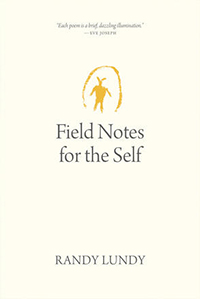Reviews
Poetry Review by Johannah Bird
Randy Lundy, Field Notes for the Self (Regina: University of Regina, 2020).
Paperbound, 96 pp., $19.95.
 Randy Lundy’s latest collection, Field Notes for the Self, invites readers to attend to the places we inhabit, beings we live alongside, and movements and evasions of our minds. The prose poems that make up the majority of the collection are written in the second person, addressing a “you” that is not the reader, not some other audience, but the speaker’s self. While this form and voice appear briefly in Lundy’s previous collection Blackbird Song, they become central in Field Notes for the Self.
Randy Lundy’s latest collection, Field Notes for the Self, invites readers to attend to the places we inhabit, beings we live alongside, and movements and evasions of our minds. The prose poems that make up the majority of the collection are written in the second person, addressing a “you” that is not the reader, not some other audience, but the speaker’s self. While this form and voice appear briefly in Lundy’s previous collection Blackbird Song, they become central in Field Notes for the Self.
As a long‐time resident of Saskatchewan, Lundy is intimately acquainted with the prairie landscape and its range of inhabitants, human and non‐human, that feature in his poems: bears, stones, trees, dogs, neighbours, snow, wind, goldfinches, etc. It is a trope, perhaps, to suggest that the prairies facilitate loneliness and solitude by virtue of their expanse, yet, for Lundy, the land hosts the solitude necessary for contemplating one’s “habits of mind” and whether “there is nothing but stories, nothing beyond,” reaffirming the land’s power to elicit poetry. In “Must All the New Answers Be the Same as the Old,” a nesting pair of merlins “all wing‐beat and screech” and creek ice that cracks “the way bones do when asked to carry too much” incite doubts about the value of solitude and stir meditations on family stories of war and intergenerational trauma. Seemingly unrelated moments in time and memory abut one another through the mind’s wandering, creating stark juxtapositions that reveal deeper, vital connections.
Many of the poems dwell in darkness, that of long winter nights accompanied by cigarettes and coffee, and that of inherited grief and violence, familial and colonial. The “you” of the poems struggles with loss, the reality of finitude, and its attendant limitations on understanding and description. In “A Minor Apocalypse,” vivid similes illustrate the challenge—and possibility—of description:
The leaves on the elm across the street, quivering
like trout pulled from a stream. Light streams
like water streams from fins, and gleam, that’s
the word you’re looking for.
The similes appear as pauses along the search for a particular word, drawing attention to the space these poems occupy on the edges of the expressible and inexpressible, between speech and reality. Here, the room for invention in between brings each element—the leaves, trout, water, light—into closer, mutually illuminating relation.
However, Lundy is ever conscious of “Coyote memory” and the “old weesageechak tricks” the mind can play in the search for meaning. In “Autumn, With Blackbirds,” the flight patterns of a blackbird murmuration are “Chinese characters, / and Arabic script, and Cree syllabics” spelling “Winter.” Yet “Pense, Saskatchewan, 2016” describes the fraught process of ascribing meaning to the natural world: “You might imagine each bird’s body … as a stone‐etched character, glyphs brought down from the mountain …. But you would be wrong.” Care must be taken in interpretation, but Lundy’s poems reveal the persistent “habit of mind” to try and “make sense of what
never does.” He brings his reflections into dialogue with poets and philosophers, Buddhist and Cree thought, in his apophatic pursuit of meaning‐making. There is “nothing frail in the bright prairie wind, nor in the returning geese,” and apple trees and maples are deep in “contemplation of no‐thought, meditating on no‐mind.” Attention to absence reveals the paradox of memory, both individual and communal: “the absence of conversation with your own dead, who are with you all the time.”
Still, all is not determined by individual perception, and the extramental world, especially the natural world where “the wild roses bloom” and “bees gather,” holds “bright particulars” that “burst the mind‐forged manacles—the now‐shattered habits of mind.” Hope for another way of being threads through the collection. A snake shedding its skin, its “Translucent scales left after / the creature slipped out of
itself,” holds the possibility of moving toward greater awareness and attention signaled by the collection’s opening epigraphs from the Brihadaranyaka Upanishad and Charles Wright. Whatever transformation might be possible, it cannot occur outside the webs of relation in which the “self,” the “you,” is embedded. Two poems leave the speaker sitting with others who carry their own memories, their own grief. “The Woman Who Dreams of Oranges” tells her own stories and dreams, putting the speaker in the position of attentive listener. Rather than falling into solipsism, the speaker’s search necessarily leads outside the self to others.
Throughout the collection, it is also easy to feel “you,” the reader, are implicated in the webs of relation Lundy explores. His persistent use of the second person creates a push‐pull effect of identification and disidentification that elicits reflections on one’s own habits of mind. However, one poem implicates the reader more readily than other poems in the collection. “Arbeit Macht Frei” details the effects of genocide on Indigenous peoples in Canada and, in doing so, shifts the identity of “you” away from the speaker toward an unspecified addressee. The effect is startling and provokes self‐examination and reflection on the relations in which we are embedded, the histories that continue to shape them, and ensuing responsibilities. Field Notes for the Self is an offering of beauty and depth that will challenge any
reader who engages with it.
—Johannah Bird









